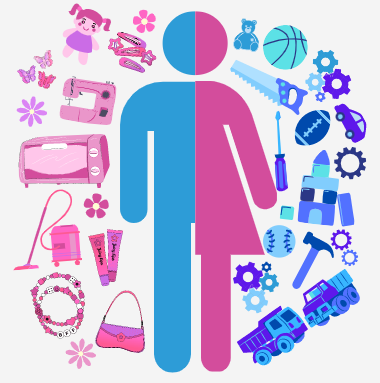
As November closes and Christmas draws nearer, everyone is eager to fill their carts during their shopping with the newest and best toys for their kids to stuff in stockings and place under the Christmas tree.
And what does every little girl or boy want for Christmas?
To conform to the status quo and be held back by gender stereotypes..
As children play with toys, they often learn certain skills or lessons. However, many of these toys hold outdated gender-specific stereotypes.
The idea of the ideal traits a female must hold has been around for centuries, following the oppression of women. The 1950s concept of women is what most imagine when they think of the perfect housewife. With television characters like Margaret Anderson, Donna Stone and June Cleaver as prime examples, every girl watched as they were expected to be good wives, meaning they cooked, cleaned and had dinner ready by the time their husbands came back from work.
Augustana College professor Jennifer Heacock-Renaud is an expert in women and gender studies. “Although men have started to perform more housework and childcare today, women still perform the bulk of what is called “the cognitive load” of the household.” Heacock-Renaud explained.
The “cognitive load” is when a member of the household takes on the jobs that aren’t physical, like managing a family.
“They anticipate and monitor the needs of the family. Women are still confined to domestic space in certain ways even though they assume work outside of the household more often,” Heacock-Renaud said.
The stigma surrounding a woman’s role in marriage and family has been outdated since the time of great suburban life shows of the 50s. But its impressions on people’s lives has not been completely lost.
Driving around in her bright pink and sparkly convertible with her perfect blonde hair and never-ending wardrobe, Barbie dolls are the third most sold toy of all time, with over 3 billion sales made. Although her main goal was, as described by creator Ruth Handler, “to show little girls that they could be anything they wanted to be,” the sense of empowerment fell short to include boys as well because it was pink, a “feminine” color. GI Joes are noted as the eighth most sold toy of all time, selling over 16 million units. They were originally sold as action dolls to combat the popularity of baby or Barbie dolls, and to give the boys something to play with because the Barbie was deemed unsuitable for boys.
Has no improvement been made whatsoever? The answer is no.
However, many companies are working to get rid of generalizations being made about sex.
With this year’s holiday season approaching, Toy Insider released a list of the best toys for any parent to buy for their little one. The first three gifts, labeled ages 3 to 4 years old, were two doll houses and a cleaning set. Although not specifically associated with a gender, both ideas of cleaning and caring for a family are associated with those stereotypical housewife qualities.
In 2012, a 13 year-old girl from New Jersey created a petition for Hasbro to create a more gender-neutral easy bake oven, since her little brother felt that he couldn’t use the product as it was designed with the intent that girls would use it. As a result, Hasbro came out with a line designed for boys that summer. However, as easy bake ovens continue to be produced, the blue and black design from 2012 has stopped being sold. The newer designs are white, with gold or indigo doors, and a big pink dial with sparkles.
Like Hasbro, other companies are working towards making the switch of phasing out gender specific labels for children’s items. In 2016, Target disbanded the search by gender function on its website. They also got rid of any gender based signs within stores. This meant that things were no longer categorized specifically for boys or girls but rather children in general.
Pleasant Valley Marketing Teacher Janene Murphy explains the process of ads being targeted towards certain genders. “They want to get as much bang for their buck as they can. That means they want to get their ads in front of people whom they know are most likely to buy their products,” Murphy continued, “So they determine their target market and then create ads that will best attract them and place them where they think their target markets will be,” Murphy said.
Brands take on preconceived notions in order to sell their products, even if that means to make generalizations.
One important note is that the definition of gender is an ever changing one, it becomes even more important to dismantle gender stereotypes, and to establish that early on in a child’s development it can allow for them to grow into who they want to be not who they are marketed to be.








